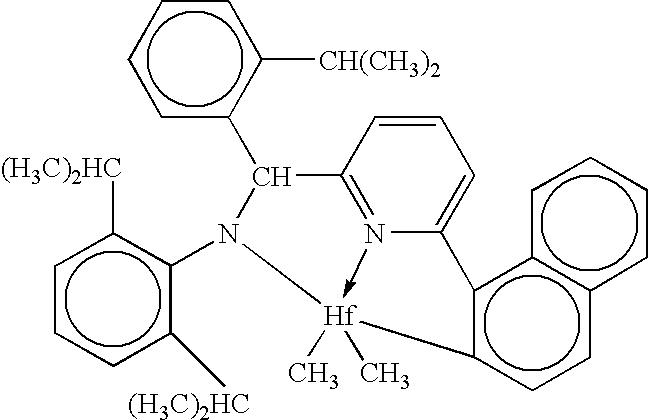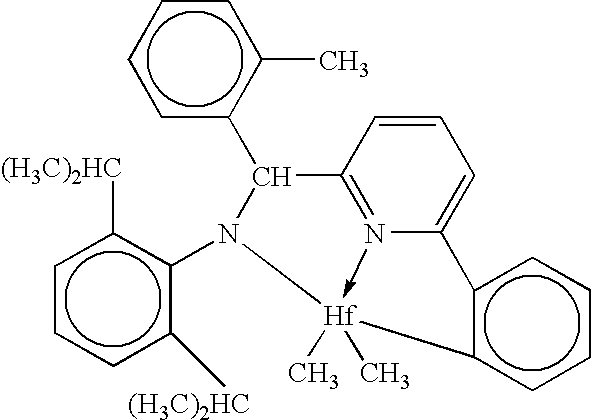Fibers made from copolymers of propylene/alpha-olefins
a technology of propylene and alpha-olefin, which is applied in the field of fibers made from propylene/olefin copolymers, can solve the problems of high cost of spandex, poor environmental resistance of spandex to ozone, chlorine and high temperature, and distinct disadvantages of spandex
- Summary
- Abstract
- Description
- Claims
- Application Information
AI Technical Summary
Benefits of technology
Problems solved by technology
Method used
Image
Examples
example 1
[0209]A propylene / ethylene block copolymer having about 12% weight percent ethylene and about 88% weight percent propylene (composition of soft segments), a melt flow rate, MFR, measured at ASTM D 1238, condition 230° C. / 2.16 kg, of about 25 g / 10 minutes, and an overall density of about 0.877 g / cm3, and an estimated hard segment content of about 30% and soft segment content of about 70% is melt spun into fine denier fiber (less than about 4 denier / filament) using a spunbonded apparatus. The melt spinning temperature is about 245° C., the throughput is about 0.5 ghm (grams / min / hole) and the fibers are drawn in the melt from a spinnerette diameter of about 600 microns down to the fiber diameter of from about 2 to less than about 4 denier per filament. The resulting nonwoven fabric is then thermally bonded under temperature of about 200-220° C. and a pressure sufficient to point bond the fibers. The individual fibers are measured for mechanical properties, and have a tensile strength o...
example 2
[0210]A propylene / ethylene block copolymer having about 12% weight percent ethylene and about 88% weight percent propylene, a melt flow rate, MFR, measured at ASTM D 1238, condition 230° C. / 2.16 kg, of about 9 g / 10 minutes, and an overall density of about 0.875 g / cm3, and an estimated hard segment content of about 30% and soft segment content of about 70% is melt spun into about 40 denier fiber (monofilament) using a melt spinning apparatus. The melt spinning temperature is about 245° C. and the fibers are drawn in the melt from a spinnerette diameter of about 800 microns down to the fiber diameter corresponding to 40 denier at a take-up speed of about 550 m / min. The fibers in the form of spools are measured for mechanical properties (prior to cross-linking), and have a tensile strength of about 1-1.5 grams / denier, an elongation to break of 450-500%, a permanent set of about 40-60% (5-cycle 300% strain, BISFA method) and a melting point of about 160° C.
example 3
[0211]A propylene / ethylene block copolymer having about 12% weight percent ethylene and about 88% weight percent propylene (composition of soft segments), a melt flow rate, MFR, measured at ASTM D 1238, condition 230° C. / 2.16 kg, of about 50 g / 10 minutes, and an overall density of about 0.877 g / cm3, and an estimated hard segment content of about 30% and soft segment content of about 70% is melt spun into micro-denier fiber (less than about 1.5 denier / filament) using a spunbonded apparatus. The melt spinning temperature is about 245° C., the throughput is 0.5 ghm (grams / min / hole) and the fibers are drawn in the melt from a spinnerette diameter of about 600 microns down to the fiber diameter of from about 1-1.5 denier per filament. The individual fibers are measured for mechanical properties, and have a tensile strength of about 2.5-3 grams / denier, an elongation to break of from about 50-100%, a permanent set of about 35-45% (2-cycle hysterisis at 100% strain) and a melting point of a...
PUM
| Property | Measurement | Unit |
|---|---|---|
| temperature | aaaaa | aaaaa |
| molecular weight distribution | aaaaa | aaaaa |
| molecular weight distribution | aaaaa | aaaaa |
Abstract
Description
Claims
Application Information
 Login to View More
Login to View More - R&D
- Intellectual Property
- Life Sciences
- Materials
- Tech Scout
- Unparalleled Data Quality
- Higher Quality Content
- 60% Fewer Hallucinations
Browse by: Latest US Patents, China's latest patents, Technical Efficacy Thesaurus, Application Domain, Technology Topic, Popular Technical Reports.
© 2025 PatSnap. All rights reserved.Legal|Privacy policy|Modern Slavery Act Transparency Statement|Sitemap|About US| Contact US: help@patsnap.com



